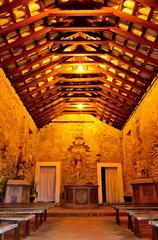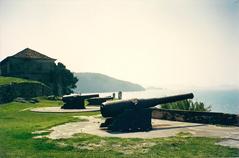Our Lady Of Exile And St. Catherine Of Alexandria Cathedral, Florianópolis
Our Lady of Exile and St. Catherine of Alexandria Cathedral Florianópolis: Visiting Hours, Tickets, and Historical Information
Date: 04/07/2025
Introduction
Located in the heart of Florianópolis, Brazil, the Our Lady of Exile and St. Catherine of Alexandria Cathedral (Catedral Metropolitana Nossa Senhora do Desterro e Santa Catarina de Alexandria) stands as a testament to the city’s colonial roots, religious devotion, and enduring cultural values. With origins dating back to 1679, this cathedral is both the spiritual nucleus of the city and a national historical landmark. Visitors are drawn to its harmonious blend of colonial and neoclassical architecture, intricate stained glass, and artistic treasures that reflect centuries of local history (wiki2.org, Wikipedia - Florianópolis).
This comprehensive guide explores the cathedral’s history, architecture, visiting details, accessibility, nearby attractions, and practical tips, ensuring a rich and informed visit to one of Florianópolis’s most cherished sites.
Table of Contents
- Introduction
- History
- Architectural Highlights
- Religious and Cultural Significance
- Visiting Information
- Nearby Attractions
- Conservation and Community Engagement
- Frequently Asked Questions (FAQ)
- Conclusion
- References
History
Early Colonial Foundations
The cathedral’s roots reach back to 1679, when Francisco Dias Velho established a chapel dedicated to the Virgin Mary, marking the genesis of the city then called Desterro. This humble limestone structure quickly became a focal point for settlers, shaping the city’s spiritual and social landscape. Despite setbacks, including the assassination of its founder within the chapel, the site remained central to the community’s identity (wiki2.org).
Architectural Evolution
As Florianópolis grew, so did its principal church. The original chapel was expanded and enhanced over centuries, adopting both colonial Brazilian and neoclassical styles. In 1908, with the establishment of the Archdiocese of Florianópolis, the church was officially elevated to cathedral status and received its current dual dedication—to Our Lady of the Exile and St. Catherine of Alexandria, patroness of Santa Catarina state (wiki2.org).
Heritage Protection
The cathedral is recognized as a protected site by Brazil’s National Historical and Artistic Heritage Institute (IPHAN), ensuring its architectural and cultural preservation for future generations (IPHAN). The building remains a living symbol of Florianópolis’s colonial heritage.
Architectural Highlights
Exterior and Facade
Distinctive for its limestone base and imposing towers, the cathedral’s exterior exemplifies the evolution of local architecture. The facade features neoclassical balconies and decorative elements from 19th and 20th-century renovations, blending harmoniously with the original colonial design (ibnbattutatravel.com). Its strategic location at Rua Arcipreste Paiva, 70, places it at the city’s historical and urban core (GCatholic.org).

Interior and Artistic Features
Inside, the nave leads to an elaborately decorated altar. The cathedral is renowned for:
- Stained Glass Windows: Vivid scenes and saints bathe the interior in colored light.
- Woodwork and Carvings: Local craftsmanship is evident in pews, confessionals, and the pulpit.
- Religious Art: Frescoes and sculptures honor the Virgin Mary and St. Catherine, while altarpieces reflect the city’s faith journey.
- Historical Layers: Parts of the original limestone chapel remain visible, offering a tangible link to Florianópolis’s origins.

Religious and Cultural Significance
Patron Saints and Community Role
The cathedral’s dual patronage is integral to its identity. Our Lady of the Exile represents refuge, echoing the city’s colonial history, while St. Catherine of Alexandria symbolizes wisdom and faith. The cathedral serves as the mother church of the Archdiocese, hosting major liturgical events—Masses, processions, and feast days for both patrons (Wikipedia - Florianópolis).
Festivals and Events
Annual festivals honor the patron saints with processions, music, and traditional foods, showcasing Azorean, Portuguese, and Brazilian heritage (Facts.net - Florianópolis). The cathedral is also active in citywide events, such as Carnival, offering special exhibitions and tours.
Visiting Information
Opening Hours and Tickets
- Opening Hours: Typically 8:00 AM to 6:00 PM Monday–Saturday, 7:00 AM to 1:00 PM on Sundays. Some sources note extended hours (6:00 AM to midnight); confirm before visiting (ibnbattutatravel.com, Florianópolis Tourism Board).
- Tickets: Entry is free; donations for maintenance are welcome.
Accessibility and Facilities
- Accessibility: Ramps and wide aisles accommodate visitors with limited mobility; some historic areas may be less accessible.
- Facilities: Restrooms and seating areas are available. The location is easily reached by foot, bus, or taxi.
Guided Tours and Visitor Tips
- Guided Tours: Occasionally available through the parish office or local guides; check ahead for schedules.
- Dress Code: Modest attire is encouraged, especially during services.
- Photography: Permitted, but avoid flash and respect ongoing services.
- Best Time to Visit: Early weekday mornings for tranquility; festival periods for vibrant local culture.
Nearby Attractions
- Praça XV de Novembro: Historic square adjacent to the cathedral, framed by colonial buildings and a centuries-old fig tree.
- Mercado Público: Lively market offering local foods and crafts, a short walk away.
- Hercílio Luz Bridge: Iconic city landmark, about a 30-minute walk from the cathedral.
- Museu da Escola Catarinense: Educational museum nearby.
- Beiramar Shopping & Iate Clube Veleiros da Ilha: For shopping and maritime experiences.
More attractions and directions can be found via Trek Zone and Tripomatic.
Conservation and Community Engagement
The cathedral’s preservation is overseen by IPHAN, with support from the local community and Archdiocese. Restoration projects safeguard original materials and artworks, while educational initiatives connect residents and visitors with Florianópolis’s religious and cultural heritage (IPHAN).
Frequently Asked Questions (FAQ)
Q: What are the cathedral’s opening hours?
A: Generally 8:00 AM–6:00 PM (Mon–Sat), 7:00 AM–1:00 PM (Sun); hours may be extended or adjusted for holidays/events.
Q: Is there an entrance fee?
A: Entry is free; donations are appreciated.
Q: Are guided tours available?
A: Occasionally, by request or during festivals/events.
Q: Is the cathedral accessible for people with disabilities?
A: Main areas are accessible; some historic sections may have limitations.
Q: Can I take photos inside?
A: Yes, but avoid flash and photographing during services.
Q: What are nearby attractions?
A: Praça XV de Novembro, Mercado Público, Hercílio Luz Bridge, and more within walking distance.
Conclusion
Visiting the Our Lady of Exile and St. Catherine of Alexandria Cathedral offers a unique window into the soul of Florianópolis. Its architectural splendor, sacred art, and active role in the community make it a must-see for history lovers, spiritual seekers, and cultural explorers alike. The cathedral’s central location also provides a gateway to further adventures in Florianópolis’s historic center.
Enhance your experience by attending a Mass, participating in a guided tour, or exploring nearby attractions. For a deeper dive, download the Audiala app for audio guides and up-to-date visitor information.






